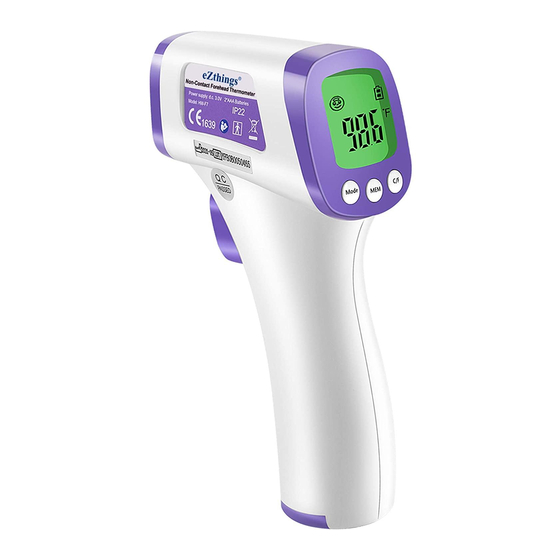
Table of Contents

Summary of Contents for eZthings HW-F7
- Page 1 Non-Contact Forehead Thermometer Model: HW-F7 Heavy Duty Sensor Compliant to IEC 60601-1, IEC60601-1-11, IEC 60601-1-2, IEC 62304, ISO80601-2-56, ASTM E1965-98 Manual instruction Please read this manual instruction thoroughly before use. Version: V2.0 Date: 2020-06-08...
- Page 2 Operating instructions Distinguish the positive and negative poles of the battery 1.Take out the thermometer and open the battery lid to install 2*AAA batteries 1.9-3.1 IN 2. Keep distance at 5cm to 8cm from thermometer probe to the middle of forehead, please do not contact forehead directly...
- Page 3 The icon for human the icon for object Measurement button body mode” ” mode” ” 3.Select measurement mode and click the measurement button to start taking temperature 4. Reading displays on the screen after successful measurement...
-
Page 4: Working Principle
Instruction Manual 1.Introduction & classification This is a Non-Contact Forehead Thermometer applicable to forehead measurement. The thermometer measures body temperature by collecting heat radiation emitting from forehead. New probe structure is adopted in this thermometer. It's simply operational, hygeian, reliable and highly accurate. Users can get precise reading within one second by one touch. - Page 5 Notice: The device is precision instrument, don’t drop, tramp or impose any vibration or impact on the thermometer. Do not touch the lens of the probe with your fingers and disassemble the device by yourself. Please make sure your forehead is clean before measuring forehead temperature.
-
Page 6: Technical Parameters
The materials (ABS) of contact with patient has passed the ISO 10993-5 and ISO 10993-10 standard test, no toxicity, allergy and irritation reaction. They compliant with requirements based on the current science and technology, and other potential allergic reactions are unknown. The patient can measure, read data and replace battery under normal circumstances and maintain the device and its accessories according to the user manual. - Page 7 for forehead temperature: Measuring accuracy(at ±0.2℃/0.4℉ during 34.0℃-42.0℃; laboratory conditions) ±0.3℃/0.5℉ during 42.1℃-43.0℃. 0.1℃/0.1℉ Resolution 15℃~40℃(59.0℉~104℉) RH≤95%Non-condensing Working condition “ERR”displays when it’s not used under working condition -25℃~55℃ (-13℉~131℉) Storage condition RH≤95%Non-condensing Power supply d.c. 3V 2*AAA Batteries When off≤10uW Power consumption When measurement≤30mW Memory...
-
Page 8: Display And Icons
7.Display & icons Function definition Icon Details The battery is in low level, but the thermometer is still When it is functional properly.Please visible replace battery asap The battery is exhausted and thermometer can not Battery level When it flashes function properly. - Page 9 Notice: 1.Temperature under human body mode is obtained from dynamic compensation of environmental temp and forehead surface temp. 2. Object temperature mode is to test surface temperature of an object. The temperature get from forehead under this mode is merely temperature of forehead surface but not body temperature.
-
Page 10: Battery Replacement
10.3 Exceeding measurement range Body mode: When measurement value is lower than 34.0ºC(93.2℉), it displays Lo (fig.10.9) and gives“beep. beep.beep.beep”, with the color of backlight turning red. When measurement value is higher than 43.0 ºC(109.4℉), it displays Hi (fig.10.10) and gives“beep. beep.beep.beep”, with the color of backlight turning red. Object mode: When measurement value is lower than 0ºC(32℉), it displays Lo (fig.10.11) and gives “beep. -
Page 11: Troubleshooting
Strong crash or hit to the product will cause its damage. Do not dismantle this thermometer by yourself. Keep the thermometer from children's reach. Do not use the thermometer under circumstance of strong electromagnetic interfere. The measurement results are probably fluctuating due to improper measurement ways. Please practice adequate measurements in order to improve your skill. - Page 12 Medical electrical equipment part 2-56: particular requirements for basic safety and essential performance ISO 80601-2-56 of clinical thermometer for body temperature measurement IEC 62304 Medical device software - Software life-cycle processes Medical devices – Application of usability engineering to IEC 62366 medical devices Biological evaluation of medical devices - Part 1: ISO 10993-1...
-
Page 13: Emc Declaration
14. EMC Declaration 1) Use of this equipment adjacent to or stacked with other equipment should be avoided because it could result in improper operation. If such use is necessary, this equipment and the other equipment should be observed to verify that they are operating normally. - Page 14 The infrared thermometer is intended for use in the electromagnetic environment specified below. The customer or the user of infrared thermometer should assure that it is used in such an environment. IEC 60601 Electromagnetic Immunity test Compliance level test level environment-guidance Floors should be wood, Electrostatic...
- Page 15 NOTE UT is the a. c. mains voltage prior to application of the test level. Guidance and manufacturer´s declaration – electromagnetic emission – for all EQUIPMENT AND SYSTEMS Guidance and manufacturer´s declaration – electromagnetic immunity The infrared thermometer is intended for use in the electromagnetic environment specified below.
- Page 16 a. The ISM (industrial, scientific and medical) bands between 150 kHz and 80 MHz are 6,765 MHz to 6,795 MHz; 13,553 MHz to 13,567 MHz; 26,957 MHz to 27,283 MHz; and 40,66 MHz to 40,70 MHz. The amateur radio bands between 0,15 MHz and 80 MHz are 1,8 MHz to 2,0 MHz, 3,5 MHz to 4,0 MHz, 5,3 MHz to 5,4 MHz, 7 MHz to 7,3 MHz, 10,1 MHz to 10,15 MHz, 14 MHz to 14,2 MHz, 18,07 MHz to 18,17 MHz, 21,0 MHz to 21,4 MHz, 24,89 MHz to 24,99 MHz, 28,0 MHz to 29,7 MHz and...
-
Page 17: Quality Commitment
For transmitters rated at a maximum output power not listed above the recommended separation distance d in metres (m) can be estimated using the equation applicable to the frequency of the transmitter, where P is the maximum output power rating of the transmitter in watts (W) according to the transmitter manufacturer.
Need help?
Do you have a question about the HW-F7 and is the answer not in the manual?
Questions and answers